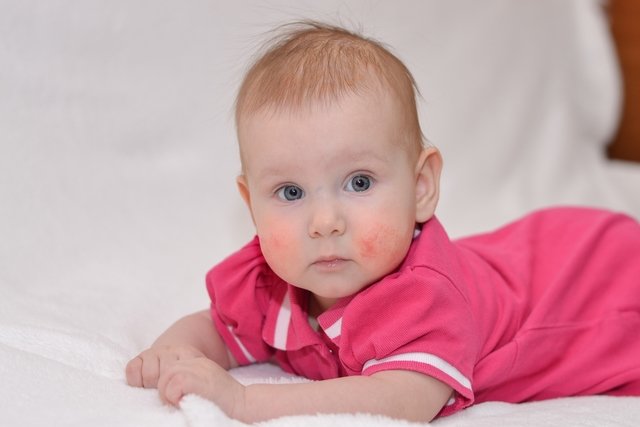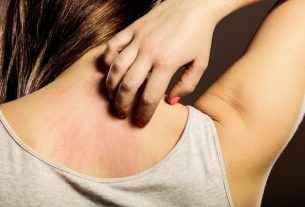Baby skin allergies can be noticed through symptoms such as red spots on the skin, itching and local irritation, which can be caused by the consumption of certain foods, contact with plants or insect bites.
Furthermore, a baby’s skin is thinner and more sensitive than that of adults, and can be easily sensitized, leading to the appearance of symptoms. Discover the most common skin problems in babies. See what the most common skin problems in babies are.
Allergies can cause a lot of discomfort for the baby, so it is important to consult a pediatrician as soon as the first changes in the skin are observed so that the cause of the allergy can be identified and treatment can begin.

Main causes
Skin allergies are common in babies, as their skin is very sensitive, and the main causes are:
1. Heat
Excessive heat, caused both by wearing too many clothes and by excessive exposure to the sun, can lead to skin irritation due to stuffy pores, with the allergy manifesting itself in the form of prickly heat.
Heat rash are small red dots that can appear on the neck, under the arms or in the diaper area, which can itch and make the baby uncomfortable and irritated.
What to do: It is important to dress the baby in clothes suitable for the climate of the region in which you live, giving preference to clothes made from light, thin and cotton fabrics, as this will help to avoid excessive heat. Furthermore, if the environment is very hot, it is a good idea to turn on the fan to alleviate the heat. To alleviate symptoms, your doctor may recommend the use of soothing creams and ointments with antihistamines.
2. Fabrics
Baby’s skin is very sensitive and, therefore, some fabrics can cause allergic reactions in the baby, such as wool, synthetics, nylon or flannel, as they prevent the skin from breathing properly.
What to do: It is recommended to identify the type of fabric to which the baby has allergy symptoms so that this type of clothing can be avoided. Furthermore, it is best for the baby to wear clothes made from cotton fabric, which, in addition to being softer and associated with fewer cases of allergies, is also a lighter fabric, preventing the emergence of prickly heat due to heat.
3. Chemical agents
Some types of talc, shampoo, moisturizing creams or fabric softeners can also cause irritation to the baby’s skin, with the appearance of red spots on the baby’s skin that may or may not be raised and cause itching, making the baby irritated.
What to do: In this case, it is important to be aware of any changes in the baby’s skin after using any of these products, as this means it is possible to avoid using them and look for alternatives. Furthermore, to alleviate symptoms, the pediatrician may recommend the use of specific moisturizers for the baby’s skin, as well as calming ointments and antihistamines.
4. Food
Some foods can cause allergic reactions in the baby and usually manifest themselves through the appearance of itchy red spots after eating a certain food or after the baby breastfeeds.
What to do: It is important to identify the food responsible for the appearance of symptoms. If the baby is still breastfeeding, it is important that the woman pays attention to her diet so that it is possible to identify the food responsible for the allergy. It may also be interesting to consult your pediatrician so that tests can be carried out to help identify the food causing the allergy. Find out how to identify and avoid food allergies in your baby.
5. Plants or herbs
Babies may experience allergy symptoms due to contact with plants that can release substances, such as poison ivy and poison oak, as well as some citrus fruits.
What to do: It is important to wash the area well and identify the plant or herb responsible for the symptoms, and it is important to avoid it.
6. Insect bites
In some children, insect bites can cause allergies, resulting in the appearance of red, itchy patches on the skin, which can be serious.
What to do: It is recommended to apply children’s repellent to the baby, in addition to leaving him dressed in loose clothing that reduces the areas most exposed to insects.
7. Atopic dermatitis
Atopic dermatitis is an inflammation of the skin that affects the skin’s protective barrier, and is caused by a combination of genetic, immunological or external factors, such as very hot water in the shower, low temperatures in winter or allergies to soap, shampoo, dust , pollen, animal dander or mold.
The symptoms of atopic dermatitis in babies are itching, redness, dryness or small bumps on the skin, being more common to affect the face, forehead, cheeks and scalp in babies up to 6 months, and knees and elbows in babies aged 6 to 12 months. . Check out all the symptoms of atopic dermatitis in babies.
What to do: You should consult your pediatrician, dermatologist or allergist, who may recommend treatment with the use of specific body moisturizers for atopic skin, or the use of ointments with corticosteroids, in addition to avoiding possible products that worsen skin lesions.
When to go to the pediatrician
It is important to go to the pediatrician when you cannot identify the cause of the baby’s allergy and persistent symptoms. The main signs of allergy on a baby’s skin are:
- Red spots on the skin;
- Itch;
- Rough, moist, dry or scaly skin;
- Presence of small bubbles or lumps;
- Crying and irritability in the baby.
As soon as signs of allergy are noticed, it is important to take the baby to the pediatrician so that the cause of the allergy can be identified and, thus, treatment can be started as soon as possible to avoid complications, such as infections, for example.
The allergy on the baby’s skin due to the diaper, which is characterized by the presence of reddish spots on the bottom or in the genital region, is not truly an allergy, but rather an irritation due to ammonia, which is a substance present in urine that attacks the baby’s skin. baby’s sensitive skin. Learn about other causes of red spots on your baby’s skin.
Make an appointment with a pediatrician in the nearest region:
Taking care of your health has never been easier!

Sign up for our newsletter and stay up to date with exclusive news
that can transform your routine!
Warning: Undefined array key "title" in /home/storelat/public_html/wp-content/plugins/link-whisper-premium/templates/frontend/related-posts.php on line 12
Warning: Undefined array key "title_tag" in /home/storelat/public_html/wp-content/plugins/link-whisper-premium/templates/frontend/related-posts.php on line 13



